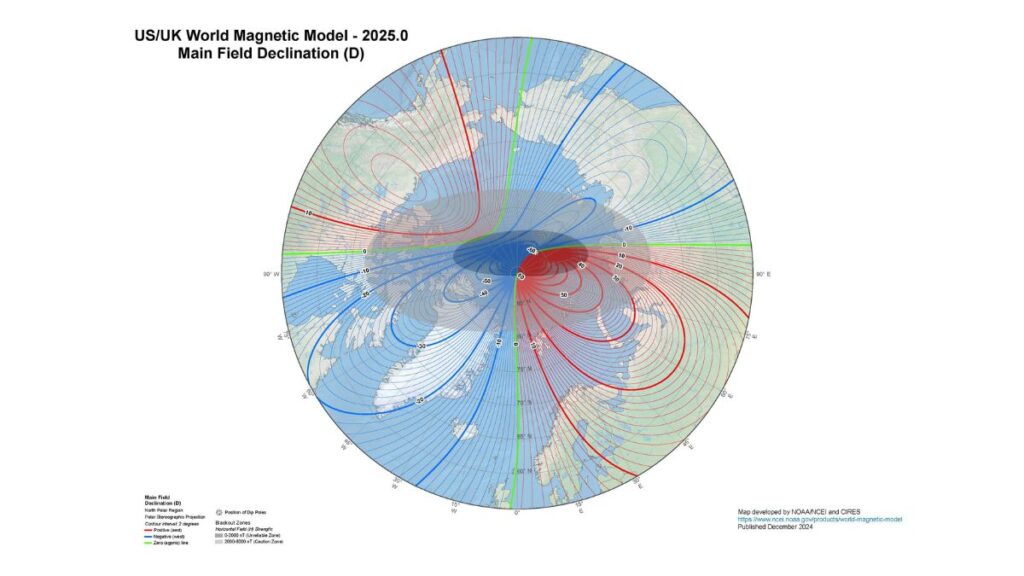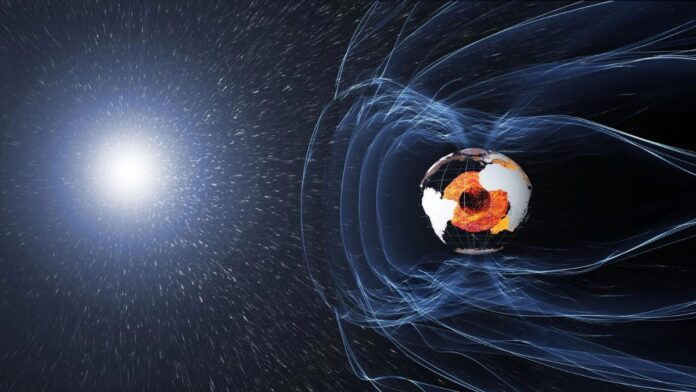The magnetic North Pole has officially shifted position, continuing its movement away from Canada and towards Siberia. The event has prompted a recalibration of navigation systems used in ships, airplanes, and other technologies.
This point on Earth, where the magnetic field points vertically downwards, is constantly changing due to the dynamic movement of iron and nickel within our planet’s core. Experts around the world collaborate every five years to update the World Magnetic Model (or WMM), a crucial tool that maps this shifting magnetic landscape. Historically, the magnetic North Pole has drifted slowly around Canada since the 1500s, but recent decades have seen an unprecedented acceleration towards Siberia, followed by a sudden deceleration in the past five years.

This unusual behavior is attributed to the influence of two large magnetic lobes beneath Canada and Siberia. The latest WMM, released in 2025, provides a more precise map of magnetic north, including a higher resolution version with ten times greater detail than previous models. This improved accuracy is vital for navigation.
For instance, a journey from South Africa to the UK using the old WMM could result in a 150 km deviation. While mapping and logistics companies, governments, and agencies will actively incorporate these updates, consumers won’t need to manually adjust their phones or satellite navigation, as the changes will be implemented automatically. Since its discovery in 1831, tracking the magnetic North Pole has become increasingly important for understanding our planet’s dynamic magnetic field.
“The more you wait to update the model, the larger the error becomes,” Arnaud Chulliat, a senior research scientist at the University of Colorado, Boulder, and NOAA’s National Centers for Environmental Information, tells Mindy Weisberger of CNN. “The way the model is built, our forecast is mostly an extrapolation given our current knowledge of the Earth’s magnetic field.”
Scientists are still unsure why the magnetic north pole’s speed changed so dramatically. Some researchers believe that changes in the strength of the magnetic field near Canada and Siberia could be influencing the shift.
“The current behavior of magnetic north is something that we have never observed before,” William Brown, a global geomagnetic field modeler at the British Geological Survey, says in a statement.
Since it was first discovered in 1831 by explorer James Clark Ross, the magnetic north pole has gradually shifted. Over the past century, its movement from Canada toward Russia has accelerated, increasing from about 6 miles per year to a peak of 31 miles annually by the 2000s. However, in the last five years, the rate of movement has slowed significantly to about 22 miles per year, the “biggest deceleration in speed we’ve ever seen,” Brown adds in the statement.
Values from the updated model can now be calculated, and the WMMHR2025 and the WMM2025 are available for download.
Ciarán Beggan, a geophysicist at the British Geological Survey, says the overall strength of Earth’s magnetic field has been decreasing over the past couple of centuries, but not uniformly. The field is getting weaker in Canada but stronger around Siberia, and “that pulls the magnetic pole towards Siberia,” Beggan tells Kasha Patel of the Washington Post.
Consequences of Shift in Magnetic North Pole
The Shifting Magnetic North Pole: Far-Reaching Consequences
The recent shift of the magnetic North Pole towards Siberia has sparked concerns among scientists, policymakers, and industries reliant on navigation and magnetic field data. As the Earth’s magnetic field continues to evolve, it’s essential to examine the potential implications of this shift on human societies, institutions, and the environment.
Effects on Navigation and Transportation
- Aviation and Maritime Industries: The magnetic North Pole’s shift will require updates to navigation systems, which may lead to increased costs and logistical challenges for airlines, shipping companies, and other transportation industries.
- GPS Technology: Although GPS systems rely on satellite signals, they also use magnetic field data for orientation. The shift may necessitate software updates and potentially affect GPS accuracy.
- Emergency Services: Emergency responders, such as search and rescue teams, may need to adapt their navigation systems to ensure accurate location.
Environmental and Climate Implications
- Climate Modeling: Changes in the Earth’s magnetic field can impact climate modeling, as magnetic field data is used to understand ocean currents and temperature fluctuations.
- Geological Research: The shifting magnetic North Pole can provide valuable insights into the Earth’s interior dynamics, potentially leading to new discoveries in geology and Earth sciences.
- Animal Migration Patterns: Some research suggests that certain animal species, such as migratory birds and sea turtles, rely on the Earth’s magnetic field for navigation. The shift may affect their migration patterns.
Societal and Economic Impacts
- Indigenous Communities: The magnetic North Pole’s shift may affect the traditional navigation methods used by indigenous communities in the Arctic region.
- Tourism and Recreation: The shift may impact the accuracy of compasses used by hikers, campers, and other outdoor enthusiasts.
- Economic Consequences: The updates required for navigation systems and the potential impacts on climate modeling and geological research may have significant economic implications for industries and governments.
Mitigation and Adaptation Strategies
- International Cooperation: Global collaboration is essential for updating navigation systems, sharing data, and addressing the challenges posed by the shifting magnetic North Pole.
- Investment in Research and Development: Governments and industries should invest in research and development to improve our understanding of the Earth’s magnetic field and its impacts on navigation, climate, and the environment.
- Public Awareness and Education: Raising public awareness about the shifting magnetic North Pole and its implications can help individuals and communities adapt to the changes.
As the Earth’s magnetic field continues to evolve, it’s crucial to stay informed and adapt to the challenges posed by the shifting magnetic North Pole. By working together and investing in research and development, we can mitigate the effects of this shift and ensure a smoother transition for industries, communities, and the environment.
Reducing the shift of the magnetic North Pole is a complex task, as it’s driven by natural processes within the Earth’s core. However, scientists have proposed several ideas to potentially slow down or mitigate the effects of the shift
Geophysical Interventions
- Artificially enhancing the geomagnetic field: Some researchers suggest that artificially generating a magnetic field could help stabilize the Earth’s magnetic field and slow down the shift.
- Influencing the Earth’s core: Another idea is to try to influence the Earth’s core by injecting materials or energy into the core-mantle boundary. However, this is still purely theoretical and requires further research.
Technological Innovations
- Improving navigation systems: Developing more accurate and reliable navigation systems that can adapt to the changing magnetic field could help mitigate the effects of the shift.
- Enhancing magnetic field monitoring: Establishing a more comprehensive network of magnetic field monitoring stations could provide earlier warnings of changes in the magnetic field, allowing for more timely adaptations.
Environmental and Conservation Efforts
- Reducing greenhouse gas emissions: Some research suggests that changes in the Earth’s magnetic field may be linked to climate change. Reducing greenhouse gas emissions could potentially help slow down the shift.
- Protecting the Earth’s core: Preserving the Earth’s core and mantle by reducing pollution, conserving natural resources, and promoting sustainable development could help maintain the stability of the magnetic field.
International Cooperation and Research
- Global research initiatives: Encouraging international collaboration and research on the Earth’s magnetic field could lead to a better understanding of the causes and consequences of the shift.
- Developing early warning systems: Creating early warning systems that can detect changes in the magnetic field could provide critical time for adaptations and mitigations.
While these ideas are being explored, it’s essential to note that the shift of the magnetic North Pole is a natural process, and it’s unclear whether human interventions can significantly impact its trajectory. Ongoing research and international cooperation are crucial for better understanding and addressing the challenges posed by the shifting magnetic North Pole.
Full size image available to download.
